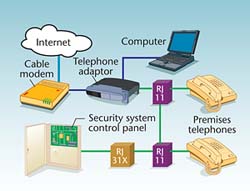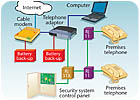- With VoIP systems, the term “backfeeding†refers to:
- the tones generated by the telephone adaptor.
- the analog to digital compression rate.
- connecting the output of the telephone adaptor to the nearest RJ-11 jack.
- None of the above
- Which of the following is a potential problem with VoIP-based systems?
- Lack of backup power
- Network outages
- Signal distortion
- All of the above
- None of the above
- Which of the following is an example of a fire alarm initiation device?
- Smoke detector
- Heat detector
- Manual pull station
- All of the above
- None of the above
- In the event of an outage of the VoIP network, the telephone adaptor may continue to provide “on-hook†voltage to the alarm control.
- True
- False
- VoIP supports both DTMF and pulse dialing.
- True
- False
- VoIP service can be provided over:
- DSL lines.
- cable.
- satellite.
- Any of the above
- None of the above
- All VoIP providers use the same compression and transmission techniques.
- True
- False
- Which of the following devices typically are connected to a 24-hour zone of a security system?
- Motion detectors.
- Tamper switches.
- Door contacts.
- All of the above
- None of the above
- It is a good idea to connect all motion detectors to a single zone of a security system.
- True
- False
- In order to use a broadband connection to monitor security systems, you must have VoIP service.
- True
- False
- In order to monitor remote, VoIP-based digital dialers, the monitoring office must have a:
- digital receiver.
- VoIP telephone line.
- broadband connection.
- All of the above
- None of the above
- The FCC regulates all Internet services including VoIP.
- True
- False
- When VoIP is used with a digital communicator, what type of cable is required between the telephone adaptor and the jack?
- CAT-6
- CAT-5
- Standard station wire
- RG-6U

What’s Wrong with This?
One of Wally `Larman’s residential customers changed his telephone service to VoIP as shown in this diagram with a self-install kit. After switching to VoIP, the digital communicator had intermittent problems transmitting signals to the monitoring office. Can you see what is causing the troubles and what Wally can do to correct the problem?5-Minute Tech Quiz Answers
- c – “Backfeeding†is a common practice with VoIP systems, where the output from the telephone adaptor is connected to the nearest RJ-11 jack at the location, providing telephone service to all other RJ-11 jacks that are wired in parallel.
- d – All of these potential problems are possible with VoIP-based systems. In fact, many VoIP providers recommend that if a remotely monitored security system is at the location, the user maintain a POTS line or other form of communication for alarm transmissions.
- d
- a – This false telephone line voltage may cause the alarm control to not alert the user about the communication network’s failure.
- b
- d
- b – Not all VoIP providers use the same compression or transmission techniques, and they may change them as the service evolves. This means that although an alarm communicator may work with one vendor, it may not always do so and may not work at all if the user switches VoIP suppliers.
- b
- b – It is better to place each device on its own zone to facilitate service or locate trouble with a false alarm.
- b – Although VoIP does require a broadband connection, you can use equipment that employs the broadband connection itself to monitor security systems. These IP-based systems offer many advantages over VoIP systems.
- a – Because VoIP is intended to replace the POTS line at the remote location, the signals that are transmitted to the monitoring office are received on a standard digital receiver.
- b – Historically, the FCC has not regulated services provided over the Internet.
- c
